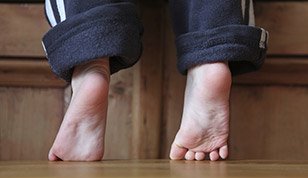Blog Categories
Search Blog
Blog Categories
Idiopathic Toe Walking
Have you noticed that your child walks on his/her tip toes when he/she walks? Does he/she seem to spend a lot of time balancing on the balls of his/her feet instead of standing with his/her feet flat on the ground?
What is idiopathic toe walking?
Idiopathic or habitual toe walking refers to pattern of walking in which the heels are off the ground and the child walks and runs on the balls of his/her feet. Most children stop this behavior within a few months of learning to walk; however, some children continue this pattern until their second birthday or beyond. This pattern of walking can happen in otherwise healthy children, with no history of medical concerns. It also appears to run in families, where one or more close family members was also an idiopathic toe walker.
How common is idiopathic toe walking?
It is estimated that approximately 5-12% of young children are idiopathic toe walkers. Many children grow out of this condition by their fifth birthday, but others continue this pattern at age 5 and beyond.
Why is toe walking a concern?
Walking on the balls of the feet can cause:
• An abnormal gait pattern
• Decreased endurance for running, playing, sports activities
• Calluses on the balls of the feet
• Tightness in the calf muscles and decreased ankle movement
• Weakness of the muscles in the front of the leg
• Altered biomechanics of the body and spine
• Decreased balance
• Pain and discomfort in calves and balls of the feet
• Difficulties keeping up with age matched peers
My child is a toe walker. What can I do about it?
If your child is a tip toe walker, treatment is available. Encourage your child to walk or stand with their feet flat on the ground. Make an appointment to see a physiotherapist who can provide specific stretches to help lengthen the tightened muscles. If the muscles do not respond to a stretching program, bracing or casting is available, or surgery as a last option. Many kids grow out of this common condition, but if you are concerned or the walking seems to be getting worse or not improving after the age of 2-3 years, bring up your concerns to your health care practioner.
Reference
The prevalence and course of idiopathic toe-walking in 5-year-old children. Engström P1, Tedroff K. Pediatrics. 2012 Aug;130(2):279-84. doi: 10.1542/peds.2012-0225. Epub 2012 Jul 23.






